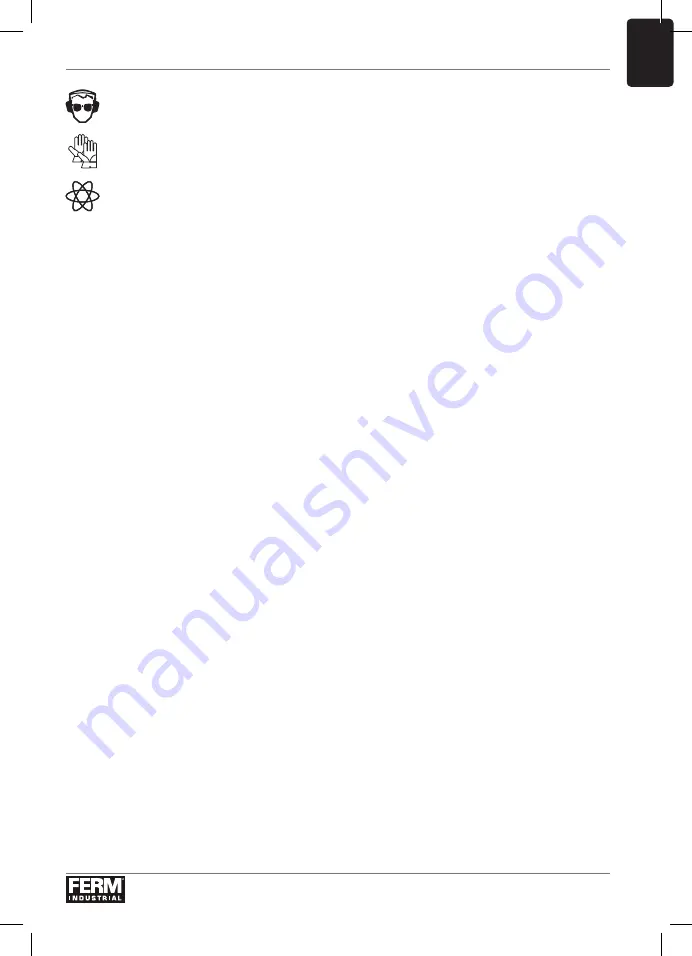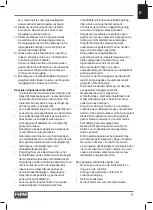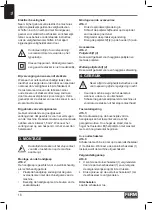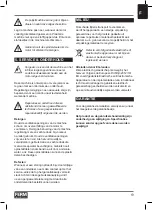
5
EN
Wear ear and eye protection.
Wear protective gloves.
Variable speed control
Safety Warnings Common for Grinding or
Abrasive Cutting-Off Operations:
a) This power tool is intended to function as a
sander, wire brush, polisher. Read all safety
warnings, instructions, illustrations and
specifications provided with this power tool.
Failure to follow all instructions listed below may
result in electric shock, fire and/or serious injury.
b) Operations such as grinding, or cutting-off are
not recommended to be performed with this
power tool. Operations for which the power tool
was not designed may create a hazard and
cause personal injury.
c) Do not use accessories which are not
specifically designed and recommended by the
tool manufacturer. Just because the accessory
can be attached to your power tool, it does not
assure safe operation.
c) Do not use accessories which are not
specifically designed and recommended by the
tool manufacturer. Just because the accessory
can be attached to your power tool, it does not
assure safe operation.
d) The rated speed of the accessory must be at
least equal to the maximum speed marked on
the power tool. Accessories running faster than
their rated speed can break and fly apart.
e) The outside diameter and the thickness of your
accessory must be within the capacity rating of
your power tool. Incorrectly sized accessories
cannot be adequately guarded or controlled.
f) The arbour size of wheels, flanges, backing
pads or any other accessory must properly fit
the spindle of the power tool. Accessories with
arbour holes that do not match the mounting
hardware of the power tool will run out of
balance, vibrate excessively and may cause
loss of control.
g) Do not use a damaged accessory. Before each
use inspect the accessory such as abrasive
wheels for chips and cracks, backing pad for
cracks, tear or excess wear, wire brush for loose
or cracked wires. If power tool or accessory
is dropped, inspect for damage or install an
undamaged accessory. After inspecting and
installing an accessory, position yourself and
bystanders away from the plane of the rotating
accessory and run the power tool at maximum
no-load speed for one minute.
Damaged accessories will normally break apart
during this test time.
h) Wear personal protective equipment.
Depending on application, use face
shield, safety goggles or safety glasses.
As appropriate, wear dust mask, hearing
protectors, gloves and workshop apron capable
of stopping small abrasive or workpiece
fragments. The eye protection must be capable
of stopping flying debris generated by various
operations . The dust mask or respirator must
be capable of filtrating particles generated by
your operation. Prolonged exposure to high
intensity noise may cause hearing loss.
i) Keep bystanders a safe distance away from
work area. Anyone entering the work area
must wear personal protective equipment.
Fragments of workpiece or of a broken
accessory may fly away and cause injury
beyond immediate area of operation.
j) Hold power tool by insulated gripping surfaces
only, when performing an operation where the
cutting accessory may contact hidden wiring
or its own cord. Cutting accessory contacting a
“live” wire may make exposed metal parts of the
power tool “live” and shock the operator.
k) Position the cord clear of the spinning
accessory. If you lose control, the cord may be
cut or snagged and your hand or arm may be
pulled into the spinning accessory.
l) Never lay the power tool down until the
accessory has come to a complete stop. The
spinning accessory may grab the surface and
pull the power tool out of your control.
m) Do not run the power tool while carrying it at
your side. Accidental contact with the spinning
accessory could snag your clothing, pulling the
accessory into your body.
n) Regularly clean the power tool’s air vents. The
motor’s fan will draw the dust inside the housing
and excessive accumulation of powdered metal
may cause electrical hazards.
o) Do not operate the power tool near flammable
materials. Sparks could ignite these materials.
Summary of Contents for AGM1120P
Page 2: ...2 Fig 1 Fig 2 Fig 3 3 5 4 1 6 2...
Page 3: ...3 Fig 4 Fig 5 Fig 6 A B 5 3 4...
Page 120: ...120 RU 180 M14 3 3 Lpa 86 3 A Lwa 97 3 A 3 51 1 5 2 EN 60745 1 1 2 3 U 4 5 6 2 O a b c...
Page 121: ...121 RU d e f g h i j k l m n o p...
Page 122: ...122 RU a b c d e 30...
Page 123: ...123 RU II 1 5 2 3 2 3 4 5 4 3 4 4...
Page 124: ...124 RU 5 6 1 1 6 1 1 6 1 5...
Page 125: ...125 UK 2012 19 EU 1400W 180mm 3 2 3 1 2 3 4 5 1 220 240 V 50 Hz 1400 1000 3300 180 M 14...
Page 126: ...126 UK 3 3 Lpa 86 3 A Lwa 97 3 A 3 51 1 5 2 EN 60745 1 1 2 3 U 4 5 6 2 a b c d e...
Page 127: ...127 UK f g h i j k l m n o p...
Page 128: ...128 UK a b c d e 1 5 2 30...
Page 129: ...129 UK 1 5 2 3 2 3 4 5 4 3 4 4 5 6 1 1 6 1 1 6 1...
Page 130: ...130 UK 5 2012 19 EU...
Page 132: ...132 EL l...
Page 133: ...133 EL...
Page 134: ...134 EL O 30 Zmax 0 348 Ohm...
Page 135: ...135 EL A H N II 1 5 mm2 3 2 3 4 5 4 3 A 4 4 5...
Page 136: ...136 EL 6 On Off 1 On Off 1 6 On Off 1 On Off 1 6 On Off 1 5 2012 19 EU...
Page 143: ...143 MK a b c c d max e f g 1 min h i j k...
Page 144: ...144 MK l m n o p a b c d e max max f...
Page 145: ...145 MK 30 s Zmax 0 348 1 5 mm2 3 2 3 5 5 4 3 4...
Page 146: ...146 MK 4 5 6 1 1 6 1 6 1 A 7 7 5...
Page 147: ...147 MK 2012 19 EU...
Page 149: ...149 Exploded view...
Page 150: ...150...
Page 152: ...WWW FERM COM 2020 FERM 2005 19...






































